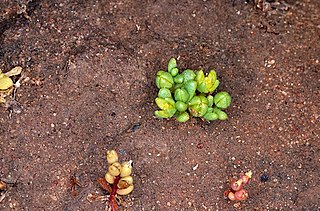
Eremophila decipiens, commonly known as slender fuchsia bush or narrow-leaved fuchsia bush is a flowering plant in the figwort family, Scrophulariaceae and is endemic to an area extending from the south-west of Western Australia to southern parts of South Australia. It is low, sprawling shrub with lance-shaped leaves and red, orange or yellow flowers on a long, S-shaped stalk.
Disphyma crassifolium, commonly known as round-leaved pigface, is a species of flowering plant in the family Aizoaceae and is native to the Australia and the Cape Provinces of South Africa. It is a prostrate, succulent annual shrub or short-lived Perennial plant with stems up to 2 m long, leaves that are three-sided in cross-section with a rounded lower angle, and purple daisy-like flowers with staminodes up to 30 mm (1.2 in) long.

Disphyma crassifolium subsp. clavellatum is the subspecies of Disphyma crassifolium that occurs in Australia and New Zealand. It is sometimes known by the common name rounded noon-flower

Gunniopsis is a genus of flowering plants in the iceplant family, Aizoaceae. These plants are found in areas of inland Australia.

Gunniopsis intermedia, commonly known as yellow salt star, is a succulent plant in the iceplant family, Aizoaceae. It is endemic to Australia.
Gunniopsis quadrifida, the Sturts pigface, is a plant endemic to Australia that is within the family Aizoaceae. This family consists of a diverse array of species that inhabit arid and/or saline coastal and inland areas, with the plants displaying leaf morphology that is conducive to such harsh environments. Typical features of members of this genus that lie within this family of succulents includes the presence of fleshy-leaves that acts as a water reservoir for the plant with the habit of a smalls shrub.
Gunniopsis zygophylloides, commonly known as the twin-leaf pigface, is a succulent plant in the iceplant family, Aizoaceae. It is endemic to Australia.
Gunniopsis divisa is a succulent plant in the iceplant family, Aizoaceae. It is endemic to Western Australia.
Gunniopsis calva, commonly known as the smooth pigface, is a succulent plant in the iceplant family, Aizoaceae. It is endemic to Australia.
Gunniopsis propinqua is a succulent plant in the iceplant family, Aizoaceae. It is endemic to Western Australia.
Gunniopsis rubra is a succulent plant in the iceplant family, Aizoaceae. It is endemic to Western Australia.

Gunniopsis septifraga, commonly known as green pigface, is a species of flowering plant in the iceplant family, Aizoaceae and is endemic to Australia. It is a prostrate to tuft-forming annual herb, with oblong to lance-shaped leaves and small greenish flowers, that grows around salt lakes.
Gunniopsis glabra is a succulent plant in the iceplant family, Aizoaceae. It is endemic to Western Australia.
Gunniopsis rodwayi is a succulent plant in the iceplant family, Aizoaceae. It is endemic to Western Australia.
Gunniopsis tenuifolia, commonly known as the narrow-leaf pigface, is a succulent plant in the iceplant family, Aizoaceae. It is endemic to Australia.

Gunniopsis papillata, commonly known as the twin-leaved pigface, is a species of succulent plant in the iceplant family, Aizoaceae and is endemic to inland areas of Australia. It is an annual herb with pimply, spatula-shaped to egg-shaped leaves and flowers with white or yellow petals.
Gunniopsis kochii, commonly known as the Koch's pigface, is a succulent plant in the iceplant family, Aizoaceae. It is endemic to Australia.
Tetragonia moorei is a member of the genus Tetragonia and is endemic to Australia.

Baumea acuta, commonly known as pale twig-rush, is a flowering plant in the sedge family, Cyperaceae, that is native to southern parts of Australia.

Carpobrotus modestus, commonly known as inland pigface, is a succulent perennial of the family Aizoaceae, native to the coasts of Australia. It produces purple flowers which mature into fruits and is mainly used as a groundcover succulent or as a drought tolerant plant.






